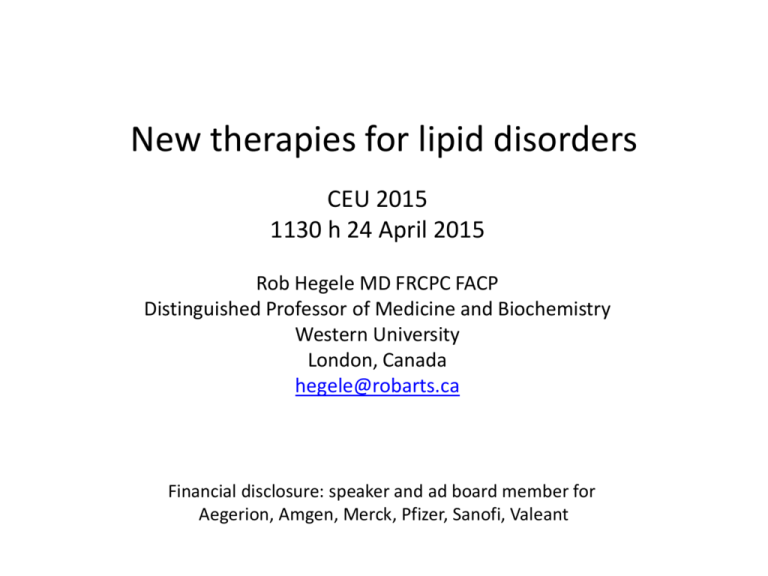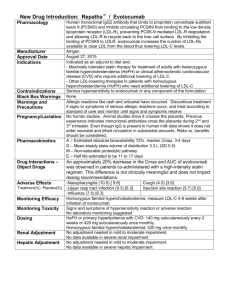
New therapies for lipid disorders
CEU 2015
1130 h 24 April 2015
Rob Hegele MD FRCPC FACP
Distinguished Professor of Medicine and Biochemistry
Western University
London, Canada
hegele@robarts.ca
Financial disclosure: speaker and ad board member for
Aegerion, Amgen, Merck, Pfizer, Sanofi, Valeant
Overview
- statins
- current second line drugs
- new drugs
LDL-C and CHD risk
Lower on-Rx LDL-C and reduced risk
% incidence of events
35
Major cardiovascular events
30
Major coronary events
25
Major cerebrovascular events
20
15
10
5
0
≥4.52
3.88-<4.52 3.23-<3.88 2.58-<3.23 1.94-<2.58 1.29-<1.94
<1.29
Achieved LDL-C concentration in mmol/L
Boekholdt SM et al. JACC 2014; 64:5485-94
Reduced all-cause mortality with statins
4S Investigators Lancet 2004; 364:771-7.
Purported Adverse Effects of Statins
Good evidence
Unproven/unlikely/idiosyncratic
- muscle-related/myopathy
- liver enzyme/transaminitis
- diabetes mellitus (related to
- cognitive impairment
- fatigue, headache, dizziness
- psychiatric complications
- inflammatory myopathies (e.g.
high-dose statin use and risk factors for
DM)
polymyositis, dermatomyositis, necrotizing myopathy)
- intracranial hemorrhage
- cataracts
- rheumatoid arthritis
- Gl-associated effects
- AKI/ renal impairment/failure
- erectile dysfunction
- gynecomastia
- interstitial lung disease
- cancer
Mancini GB et al. Can J Cardiol. 2013; 29:1553-1568.
Statins and New Onset T2DM
Effect of statins on T2DM is not
confined to rosuvastatin
However….
“The
cardiovascular
and mortality
benefits of statin
therapy exceed
the diabetes
hazard, including
in participants at
high risk of
developing
diabetes”
Adapted from Ridker PM et al. Lancet 2012; 380(9841):565-71; Bell DS and O’Keefe JH, Diabetes, Obes and Metab 2009; 11(12):1114–
Second line drugs
1. Bile acid sequestrants
2. Ezetimibe
3. Fibrates
4. Niacin
Bile acid sequestrants
Lipid Research Clinics Coronary Primary Prevention Trial (LRC-CPPT)
Life-Table Cumulative Incidence (%)
12
Life-table cumulative
incidence of primary end point
(definite CHD death and/or definite
nonfatal MI) in treatment groups,
computed by Kaplan-Meier method.
10
8
Placebo
6
4
Cholestyramine resin
2
0
1
2
3
4
5
6
Years of Follow up
7
8
9
Lipid Research Clinics. JAMA 1984;251:351-364.
9
LDL-C and Lipid Changes
1 Yr Mean
Mean LDL-C (mmol/L)
2.5
2.25
LDL-C
TC
TG
HDL
hsCRP
Simva
1.81
3.75
1.55
1.24
3.8 mg/dl
EZ/Simva
1.38
3.25
1.36
1.26
3.3 mg/dl
Δ in mmol/L
-0.43
-0.50
-0.19
+0.2
-0.5mg/dl
2.0
1.75
median time avg
1.8 vs. 1.4 mmol/L
1.5
1.25
1.0
QE R
Number at risk:
1 4 8 12 16 24 36 48 60 72 84 96
Time since randomization (months)
AHA Scientific Sessions, 17 Nov 2014
Primary Endpoint — ITT
Cardiovascular death, MI, documented unstable angina requiring
rehospitalization, coronary revascularization (≥30 days), or stroke
HR 0.936 CI (0.887, 0.988)
p=0.016
Simva — 34.7%
2742 events
NNT= 50
EZ/Simva — 32.7%
2572 events
7-year event rates
AHA Scientific Sessions, 17 Nov 2014
IMPROVE-IT vs. CTT:
Ezetimibe vs. Statin Benefit
IMPROVE-IT
CTT Collaboration.
Lancet 2005; 366:1267-78;
Lancet 2010;376:1670-81.
Fibrates: Gemfibrozil Reduced Cardiovascular Events
in Patients with CAD by 22%
Adapted from Rubins HB, Robins SJ, Collins D et al. NEJM 1999;341(6);410-8
ACCORD-Lipid: MACE
Possible role for fibrates
High TG, low HDL-C subgroups
Normolipidemic subgroups
15
N Engl J Med 2010; 363:692-695
Coronary Drug Project:
Effect of Niacin in Post-MI Patients
Cumulative Rate of Nonfatal MI in
Post-MI Patients Treated With Niacin or Placebo
Cumulative Event Rate (%)
15
Recurrent
nonfatal MI
Placebo
Niacin
10
27%
5
(P < 0.004)
0
12
34
36
48
Months of Follow-up
60
Patients receiving niacin (n=1119) vs patients receiving placebo (n=2789). Total mortality
was similar between the 2 groups at 5 years.
The Coronary Drug Project Research Group. JAMA. 1975;231:360-381.
HPS2-THRIVE: Major Vascular Events on
Niacin/Laropiprant (ERN/LRPT)
Patients suffering events (%)
20
15
15.0%
14.5%
10
Placebo
ERN/LRPT
5
Risk ratio 0.96
(95% CI 0.90–1.03)
Logrank P=0.29
0
0
1
2
Years of follow-up
3
4
Adapted from Armitage J, et al "HPS2-THRIVE: Randomized placebo-controlled trial of ER Niacin and laropriprant in
25,673 patients with pre-existing cardiovascular disease" ACC 2013.
CVD end point reduction
Drug class
Bile acid
sequestrants
Ezetimibe
Fibrates
Niacin
No background With background
statin
statin
Yes (LRC-CPPT)
Not done
Not done
Yes (HHS, VA-HIT)
Yes (CDP)
Yes (SHARP; IMPROVE-IT)
No (ACCORD, FIELD)
No (AIM-HIGH, HPS2)
Combination treatment: safety
Very safe:
statin + bile acid sequestrant
statin + ezetimibe
Quite safe:
statin + niacin
statin + fenofibrate
statin + bezafibrate
Riskier statins:
lova, simva
Reduce dose:
fenofibrate if creatinine > 150
Avoid:
statin + gemfibrozil
19
Non-pharmacological LDL-lowering
Compound
Dose
% LDL lowering
Evidence level
Isoflavones (soy protein powder)
50-100 mg
3-11%
A-I
Soluble fibre
5-15 g
5-20%
A-I
Oatmeal
60 g
2-6%
A-I
Plant sterols
1.3 g
4-13%
A-I
AHA Step 2 diet
5-10%
A-I
Mediterranean diet
5-10%
A-I
Portfolio diet
10-20%
A-I
Almonds
50-80 g
5%
B-I
Green tea extract
1.2 g
10%
B-I
High carb diet
60% of calories
5-10%
B-I
High protein diet
25% of calories
5-10%
B-I
Red yeast rice
1-2 g
7-20%
A-IIa
Guggulipid
100 mg
12%
A-IIb
Huang et al. Can J Cardiol 2011: 488-505
Looking forward to the 2015 guidelines
• keep LDL-C targets
• combination Rx
• non-statin LDL-C lowering
• non-HDL-C as alternate
• non-fasting lipids
• ongoing RCTs – PCSK9i lower LDL-C < 1.0 mmol/L
• ongoing RCTs – CETP inhibitors
Emerging lipid therapies
- lomitapide
- mipomersen
- anti-PCSK9
- CETP inh (ana, eva)
effect
lowers LDL-C by 50%
lowers LDL-C by 50%
lowers LDL-C by 80%
lowers LDL-C by 40%
- alipogene tiparvovec
- anti-APOC3
- anti-ANGPTL
lowers TG by 30%
lowers TG by 50%
lowers TG by 50%
Four Mechanisms for Reducing LDL-C
Lilly SM, Rader DJ. Curr Opin Lipid. 2007;18:650–655.; Shinkai H. Vasc Health Risk Manag. 2012;8:323-331.
Serum
LDL-Cholesterol
Bindsthe
to LDL-Receptors.
In
the
Presence
of
PCSK9,
LDL-R Is Degraded
Following Internalization, LDL is Degraded and the
and
DoesRecycled
Not Cycle Back to Cell Surface
Receptor
Qian YW, et al. J Lipid Res. 2007;48:1488-1498.
Horton JD, et al. J Lipid Res. 2009;50(suppl):S172-S177.
Blocking
PCSK9
Activity
Inhibits
Monoclonal
Antibody
binds
to PCSK9 and
Intracellular
Degradation
of LDL-R
inhibits Binding
to the LDL-Receptor
Qian YW, et al. J Lipid Res. 2007;48:1488-1498.
Horton JD, et al. J Lipid Res. 2009;50(suppl):S172-S177.
PCSK9-Directed Therapies in Development
Company
Drug
Agent
Indication
Phase
Inhibition of PCSK9 binding to LDLR
Amgen
Evolocumab
Fully Human mAb
Hypercholesterolemia
3
Sanofi/Regeneron
Alirocumab
Fully Human mAb
Hypercholesterolemia
3
Bococizumab
mAb
Hypercholesterolemia
3
Novartis
LGT209
mAb
Hypercholesterolemia
2
Roche/ Genentech
RG7652
mAb
Hypercholesterolemia
2
LY3015014
mAb
Hypercholesterolemia
2
Adnexins
Hypercholesterolemia
1
ALN-PCS02
siRNA oligonucleotides
Hypercholesterolemia
2
TBD
Antisense oligonucleotide
Hypercholesterolemia
Preclinical
SX-PCK9
Small peptide mimetic
Hypercholesterolemia
Preclinical
Shifa Biomedical
TBD
Small molecule
Metabolic Disorders
Preclinical
Cadila Healthcare
TBD
Small molecule
Pfizer/Rinat
Neuroscience
Eli-Lilly
PCSK9 protein binding fragment
BMS/ Adnexus
BMS-962476
Inhibition of PCSK9 synthesis (gene silencing)
Alnylam
Idera
Inhibition of PCSK9 autocatalytic processing
Seometrix
Preclinical
mAb: monoclonal antibody; CVD: cardiovascular disease
Adapted from Rhainds D, et al. Clin Lipidol. 2012;7:621-640.;Lambert G, et al. J Lipid Res. 2012;53:2515-24;clinicaltrials.gov; Stein EA.
Swergold GR. Curr Atheroscler Rep. 2013:15:310.
Terminology of Monoclonal Antibodies
Mouse
(% human protein) (0% human)
Source
Generic suffix:
High
-omab
Chimeric
(65% human)
Humanized
(> 90% human)
-ximab
-zumab
Potential for immunogenicity
1. Weiner LM. J Immunother. 2006;29:1-9.; 2. Yang XD, et al. Crit Rev Oncol Hematol. 2001;38:17-23.;
3. Lonberg N. Nat Biotechnol. 2005;23:1117-1125.; 4. Gerber DE. Am Fam Physician. 2008;77:311-319.
Human
(100% human)
-umab
Low
Evolocumab: effect on LDL-C
LDL-C 3.1 mmol/L
LDL-C 1.24 mmol/L
Sabatine M et al. NEJM Mar 2015 online
Evolocumab: CVD reduction
Sabatine M et al. NEJM Mar 2015 online
Evolocumab: adverse events
Sabatine M et al. NEJM Mar 2015 online
Alirocumab: effect on LDL-C
Robinson J et al. NEJM Mar 2015 online
Alirocumab: CVD reduction
Robinson J et al. NEJM Mar 2015 online
Alirocumab: adverse events
Robinson J et al. NEJM Mar 2015 online
Four Mechanisms for Reducing LDL-C
Lilly SM, Rader DJ. Curr Opin Lipid. 2007;18:650–655.; Shinkai H. Vasc Health Risk Manag. 2012;8:323-331.
Lomitapide: LDL-C change from baseline
Mean % change in LDL-C (±95%CI)
(Week 126 Completers Population)
10
Phase 3
0
Long-Term Extension
–10
–20
–30
–40
–50
–60
–70
–80
n:
0
10
18
26
36
46
56
66
Week
78
90
102
114
126
17
17
16
17
17
17
17
17
17
17
17
17
17
35
Proprietary. ©2014 Aegerion Pharmaceuticals, Inc. All Rights Reserved.
Juxtapid is a trademark of Aegerion Pharmaceuticals, Inc. Licensed User Aegerion Pharmaceuticals (Canada) Ltd.
APOB antisense: mipomersen in HoFH
Raal D et al. Lancet 2010; 375:998-1006.
CETP inhibition: effect on LDL-C
Kastelein J et al. Lancet 2015 75:998-1006.
CETP inhibition: effect on HDL-C
Kastelein J et al. Lancet 2015 75:998-1006.
Summary
-
statins are good
LDL-C targets will remain in guidelines
second line drugs work – depends on context
novel Rx for LDL-C:
-
PCSK9 inhibitors
lomitapide
APOB antisense
CETP inhibitors






